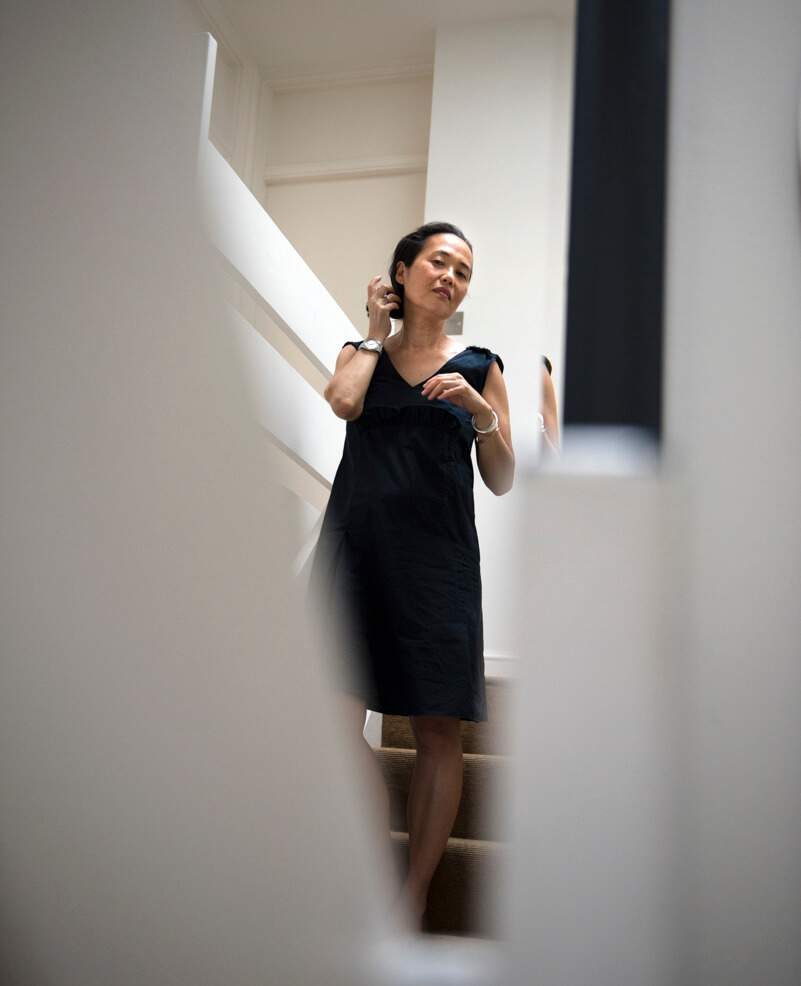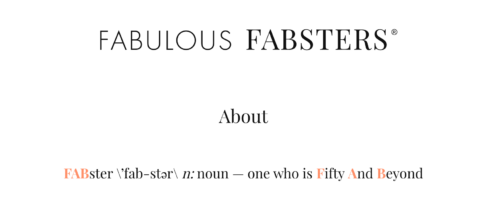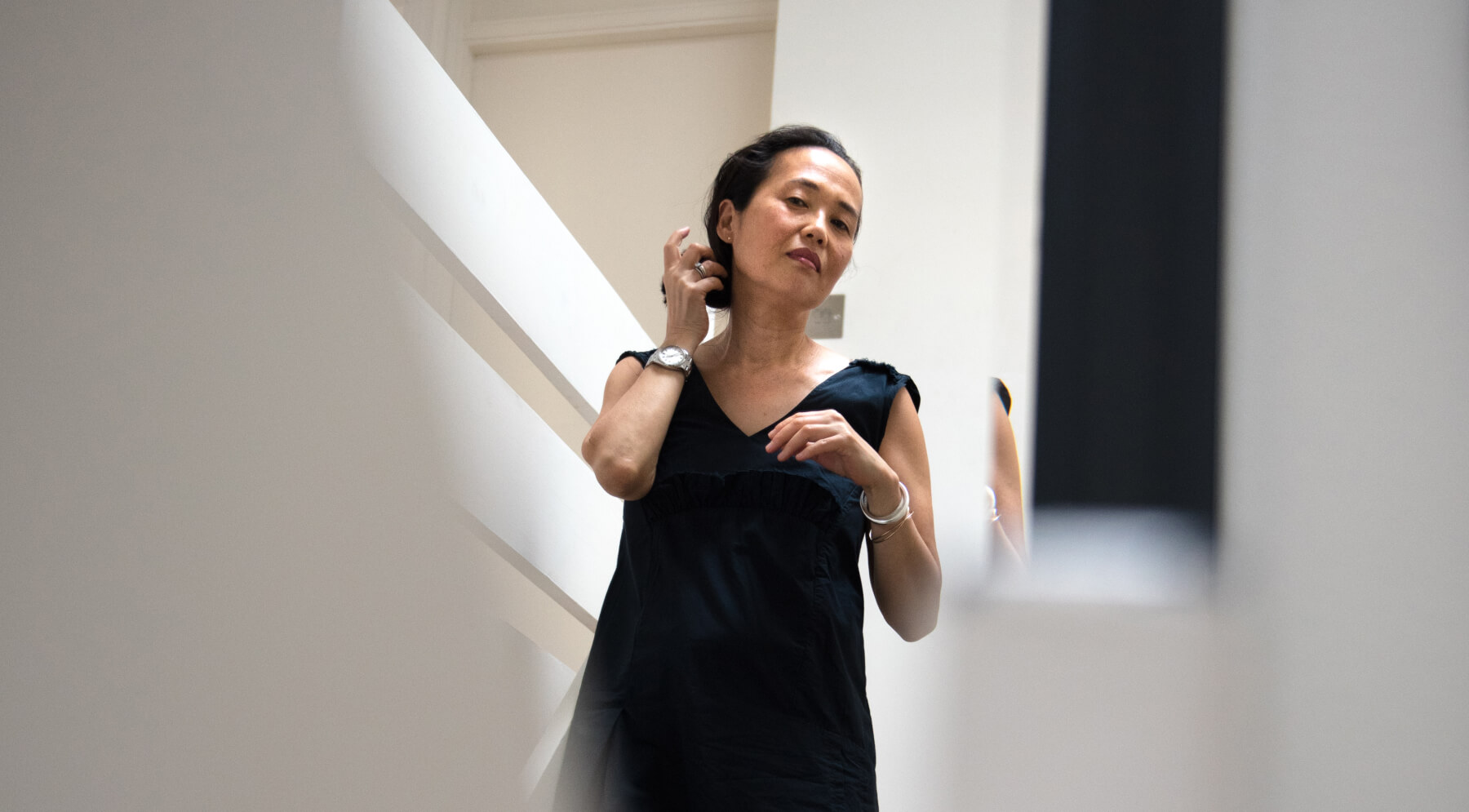
Christine on the stairway in her London home that she and her architect husband have designed together. Photo Credit: Fiona Bailey
We call them The Pushers—women who are pushing themselves in new directions and toward new passions. We hope that through their inspiration in this regular feature, they’ll push you to take a leap of your own—or maybe just a small first step.
It was at her small all-girls’ Connecticut boarding school that Christine Chang Hanway initially realized the potential impact of good design. The building where the students did everything — ate, slept, went to classes, and attended chapel — was designed in 1909 by one of the first female architects in the country, Theodate Pope Riddle.
In those carefully considered spaces, Christine experienced first hand how design could enhance the lives and interactions of the wider school community. Despite her English teacher’s protestations, Christine went on to pursue a career in architecture. With a Masters in Architecture from the Harvard Graduate School of Design, she headed to New York to work for the prestigious architecture firm Pei Cobb, Freed and Partners. The United States Holocaust Museum, a project in the office at the time, inspired her to explore how design might help to tell stories in space and she began working on museums and exhibitions.
Despite her English teacher’s protestations, Christine went on to pursue a career in architecture.
This interest in narrative developed into a full-time writing career where she wrote about architecture and design for the website Remodelista and its sister site Gardenista. Eventually Christine came to see that she just wanted to tell stories and she founded Fabulous Fabsters, a website dedicated to women who are FAB — Fifty And Beyond. It makes her smile to think that her English teacher — a definite Fabulous Fabster — was right the whole time. Based in London with her husband and their two sons for twenty-three years, Christine loves her adopted hometown for its history and humor. .
What kind of work did you do within architecture and design in your career? What was your specialty?
At Pei Cobb Freed and Partners, I was assigned by chance to work with Jim Freed on the United States Holocaust Museum in Washington D.C. I was a lowly model builder and we were building a huge ¾” scale model of the two-story atrium hall — you could put your entire head into this massive model and truly experience the architect’s vision and how he wanted people to move through the space while absorbing the seriousness of the Holocaust.
I found myself working on the United States Holocaust Museum again, but this time I was designing the exhibitions as opposed to the architecture.
This was when I realized that I wanted to work with narrative in design and moved across into museum and exhibition design. I was interested in telling stories in space effectively and went to work for Ralph Appelbaum and Associates, best known for their seminal work in museology in the 90s. I found myself working on the United States Holocaust Museum again, but this time I was designing the exhibitions as opposed to the architecture. When my family moved to London in the mid 90s, I worked on the Holocaust Exhibition at the Imperial War Museum and the master plan of the Victoria and Albert Museum
What are some of the projects you are most proud of—as far as design and architecture?

Christine asked to work on the Tower of Faces exhibit at the U.S. Holocaust Museum. “My role was in design development and production, working on how the photos were reproduced and attached to the structure of the building,” she says. Photo credit: Ted Eytan
I’m most proud of working on the two Holocaust Exhibitions, the one in D.C and the one in London. At the time, the concept of integrating an exhibition into the architecture of the space was at its infancy. Successful integration required the efforts of many teams of people — historians, architects, product designers, graphic designers. It was a unique learning experience and every challenge was new. That was exciting. It felt good to know that by telling a story well, we were helping people to understand an important part of history.
When did you decide you wanted to write/edit?
I don’t think I ever decided to write and edit. I fell into it rather organically. I stopped working as an architect eight years ago when our youngest son was 12 and diagnosed with various learning issues. I wanted to help him manage his challenges.
I became totally engrossed in the world of digital communication.
At about the same time, my friend Julie Carlson asked me to write about London design and architecture for her website Remodelista, and I started contributing as my schedule allowed. By the time my son successfully moved on to high school, I had joined Remodelista full-time as the UK Editor. Telling design stories everyday through a fast and direct medium like the internet was liberating and learning how to harness the powerful communication benefits of social media was exciting. I became totally engrossed in the world of digital communication.
Is it frustrating to be writing about other people’s projects instead of designing projects yourself?
Not at all! I’m quite an impatient person, and I prefer the pace of writing to that of design and construction. I went from working on projects that took years to complete to posts that could be completed in weeks or hours even. I get to see the results of a lot more projects this way. Also, I haven’t stopped designing completely. Over the years, my husband, an architect who typically works on large-scale master-plan projects, and I have embarked on many design projects around the house.
What’s the difference in your mind between designing say a building or an interior and writing a piece? What kind of skills are required in each one?
Personally, I’m not sure there is much difference because since I was young, I have always been designing across various disciplines. I had dolls but didn’t really play with them. Instead, I was always designing and making things for them, from clothes to room sets. I once constructed a mobile home for them that packed away like a suitcase so I could take my dolls with us on our family road trips.
I’ll never forget the shocked look on my mother’s face when I showed her the mid-century cone fireplace I had constructed for my dolls out of one of those cardboard cylinders from tampons.
Design is about solving problems — I’ll never forget the shocked look on my mother’s face when I showed her the mid-century cone fireplace I had constructed for my dolls out of one of those cardboard cylinders from tampons. When it came to designing the website, my design skills were very useful. I was able to give my website developer a very clear brief, which is like building a good foundation. Design is a very iterative process. You start with an idea and then you test it and go back to the drawing board. You keep repeating that process until it’s right. It’s how my posts come together, too.
Why did you begin Fabulous Fabsters?

Christine receiving her Master’s Degree from Harvard Graduate School of Design.
My newly acquired digital skills introduced me to a new landscape, filled with the talents of a much younger generation — one that is actually much closer in age to my 22- and 20-year-old sons than to mine. Working with and learning from youth has been invigorating — not to mention age defying — and I now feel that I am in a unique position to introduce women of my generation to the advantages of being part of a larger digital community. With Fabulous Fabsters, we tell the stories about women who are FAB — Fifty And Beyond. When I was growing up, there was this misconception that life for women somehow ended after menopause. It wasn’t true then, and it certainly isn’t true now. Fabulous Fabsters will hopefully raise this awareness and inspire younger women to welcome this next phase of their lives.
Working with and learning from youth has been invigorating — not to mention age defying.
Our readers find inspiration in the enthusiasm that comes across from these women. Most interesting have been the comments from younger women who have told me that the site has given them a reason to embrace aging. One twenty-year-old woman told me that she found the site empowering. I’ll take that.
What do you hope to achieve with your writing and your site?
 I started Fabulous Fabsters to highlight the lives and achievements of women who are Fifty And Beyond. For various reasons, the paths women take in life are often not linear and their successes can be less visible, especially when being judged against more traditional criteria. This is my way of changing other people’s perceptions, as well as our own, about the potential contributions Fabsters can make to their communities and to the world around us.
I started Fabulous Fabsters to highlight the lives and achievements of women who are Fifty And Beyond. For various reasons, the paths women take in life are often not linear and their successes can be less visible, especially when being judged against more traditional criteria. This is my way of changing other people’s perceptions, as well as our own, about the potential contributions Fabsters can make to their communities and to the world around us.





















0 Comments